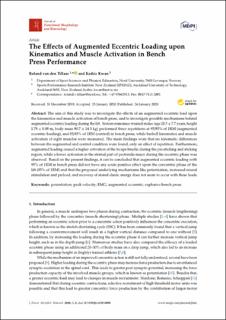The effects of augmented eccentric loading upon kinematics and muscle activation in bench press performance
Peer reviewed, Journal article
Published version
Permanent lenke
https://hdl.handle.net/11250/2730585Utgivelsesdato
2020Metadata
Vis full innførselSamlinger
Originalversjon
van den Tillar, R. & Kwan, K. (2020). The effects of augmented eccentric loading upon kinematics and muscle activation in bench press performance. Journal of Functional Morphology and Kinesiology, 5(1): 8. doi: 10.3390/jfmk5010008Sammendrag
The aim of this study was to investigate the effects of an augmented eccentric load upon the kinematics and muscle activation of bench press, and to investigate possible mechanisms behind augmented eccentric loading during the lift. Sixteen resistance-trained males (age 28.5 ± 7.7 years, height 1.78 ± 0.08 m, body mass 80.7 ± 14.3 kg) performed three repetitions at 95/85% of 1RM (augmented eccentric loading), and 85/85% of 1RM (control) in bench press, while barbell kinematics and muscle activation of eight muscles were measured. The main findings were that no kinematic differences between the augmented and control condition were found, only an effect of repetition. Furthermore, augmented loading caused a higher activation of the biceps brachii during the pre-sticking and sticking region, while a lower activation in the sternal part of pectoralis major during the eccentric phase was observed. Based on the present findings, it can be concluded that augmented eccentric loading with 95% of 1RM in bench press did not have any acute positive effect upon the concentric phase of the lift (85% of 1RM) and that the proposed underlying mechanisms like potentiation, increased neural stimulation and preload, and recovery of stored elastic energy does not seem to occur with these loads.

